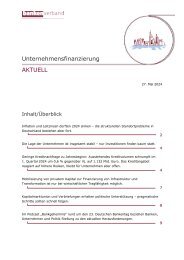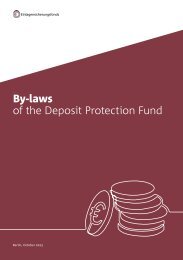Regulation of shadow banking
Shadow banking is given a large share of the blame for the financial crisis. This perception raises the question of what kind of shadow banking system should remain in place in the future.
Shadow banking is given a large share of the blame for the financial crisis. This perception raises the question of what kind of shadow banking system should remain in place in the future.
You also want an ePaper? Increase the reach of your titles
YUMPU automatically turns print PDFs into web optimized ePapers that Google loves.
8<br />
Workstream V: Securities lending and repos<br />
Securities lending and repo transactions are used<br />
in many different ways in the financial markets.<br />
They are indispensable instruments for refinancing<br />
banks, funding companies and ensuring liquidity.<br />
What is more, they are a fundamental element <strong>of</strong><br />
the transmission mechanism <strong>of</strong> monetary policy. Any<br />
regulation targeting <strong>shadow</strong> <strong>banking</strong> in this area<br />
therefore needs also to consider the use <strong>of</strong> securities<br />
lending and repos outside <strong>shadow</strong> <strong>banking</strong>. Otherwise,<br />
the smooth functioning <strong>of</strong> financial markets could be<br />
unintentionally impaired.<br />
The FSB’s publications indicate that the authors are<br />
well aware <strong>of</strong> the complexity involved in the task<br />
<strong>of</strong> regulating securities lending and repos. In April<br />
2012, an interim report was published describing<br />
and categorising the global markets for securities<br />
lending and repo transactions. 37) This was followed in<br />
November 2012 by an initial consultative document. 38)<br />
The approach taken by the FSB was to identify the risks<br />
to financial stability which can arise from repos and<br />
securities lending, and, at the same time, set out policy<br />
recommendations for addressing these risks.<br />
Conscious that repo markets have a fundamental<br />
importance for the financial system as a whole, the<br />
FSB sought from the outset to avoid disruption. To this<br />
end, the first part <strong>of</strong> a two-phase quantitative impact<br />
study (QIS) was launched in April 2013. The final policy<br />
recommendations, together with consultative proposals<br />
for the introduction <strong>of</strong> minimum haircuts, were unveiled<br />
at the end <strong>of</strong> August 2013. The second QIS, which<br />
followed in November 2013, was conducted to assess<br />
the impact <strong>of</strong> these proposals.<br />
The FSB’s recommendations can be divided into three<br />
broad categories:<br />
1. Improvements in transparency<br />
2. <strong>Regulation</strong> <strong>of</strong> securities financing<br />
3. Structural aspects <strong>of</strong> the securities financing<br />
markets<br />
To address one <strong>of</strong> the most important problems <strong>of</strong><br />
regulating securities lending and repos – namely the<br />
lack <strong>of</strong> available data – the FSB has created a new<br />
group <strong>of</strong> data experts. Market participants and the FSB<br />
continue to disagree on the question <strong>of</strong> introducing<br />
minimum haircuts. For this reason, a fresh round <strong>of</strong><br />
consultation was carried out until the end <strong>of</strong> November<br />
2013, and the FSB’s final proposals on minimum haircut<br />
standards are scheduled for release in spring 2014.<br />
The FSB believes that the following risks to financial<br />
stability can arise in securities lending and repo<br />
markets, and that regulation is therefore needed to<br />
mitigate these risks.<br />
Pure <strong>shadow</strong> <strong>banking</strong> risks<br />
• Repos create money-like liabilities, facilitating credit<br />
growth and maturity and liquidity transformation<br />
outside the <strong>banking</strong> system.<br />
• The reinvestment <strong>of</strong> cash collateral from securities<br />
lending transactions gives rise to liquidity and<br />
leverage risks.<br />
Risks that span regular <strong>banking</strong> and <strong>shadow</strong> <strong>banking</strong><br />
• Tendency <strong>of</strong> securities financing to increase<br />
procyclicality in the financial system<br />
• Risk <strong>of</strong> a fire sale <strong>of</strong> collateral<br />
37) www.financialstabilityboard.org/publications/r_120427.pdf<br />
38) www.financialstabilityboard.org/publications/r_121118b.pdf<br />
30 <strong>Regulation</strong> <strong>of</strong> <strong>shadow</strong> <strong>banking</strong>


















